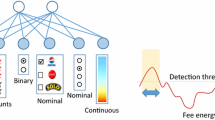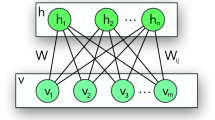Abstract
Data-driven methods are implemented using particularly complex scenarios that reflect in-depth perennial knowledge and research. Hence, the available intelligent algorithms are completely dependent on the quality of the available data. This is not possible for real-time applications, due to the nature of the data and the computational cost that is required. This work introduces an Automatic Differentiation Variational Inference (ADVI) Restricted Boltzmann Machine (RBM) to perform real-time anomaly detection of industrial infrastructure. Using the ADVI methodology, local variables are automatically transformed into real coordinate space. This is an innovative algorithm that optimizes its parameters with mathematical methods by choosing an approach that is a function of the transformed variables. The ADVI RBM approach proposed herein identifies anomalies without the need for prior training and without the need to find a detailed solution, thus making the whole task computationally feasible.










Similar content being viewed by others
References
Boubekeur M (2017) Industrial applications for cyber-physical systems. In: 2017 first international conference on embedded distributed systems (EDiS), pp 59–59. https://doi.org/10.1109/EDIS.2017.8284020
Banafa A (2018) 2 The Industrial Internet of Things (IIoT): challenges, requirements and benefits. In: Secure and smart internet of things (IoT): using blockchain and AI, river publishers, pp 7–12. [Online]. https://ieeexplore.ieee.org/document/9226906. Accessed 19 Jan 2021
Radanliev P et al (2020) Cyber risk at the edge: current and future trends on cyber risk analytics and artificial intelligence in the industrial internet of things and industry 4.0 supply chains. [Online]. https://www.preprints.org/manuscript/201903.0123/v2. Accessed 19 Jan 2021
Demertzis K, Iliadis L, Tziritas N, Kikiras P (2020) Anomaly detection via blockchained deep learning smart contracts in industry 4.0. Neural Comput Appl 32(23):17361–17378. https://doi.org/10.1007/s00521-020-05189-8
Chalapathy R, Chawla S (2019) Deep learning for anomaly detection: a survey. [Online]. Preprint http://arxiv.org/abs/1901.03407. Accessed 08 Sep 2021
Tsiknas K, Taketzis D, Demertzis K, Skianis C (2021) Cyber threats to industrial IoT: a survey on attacks and countermeasures. IoT. https://doi.org/10.3390/iot2010009
Deorankar AV, Thakare SS (2020) Survey on anomaly detection of (IoT)- Internet of Things cyberattacks using machine learning. In: 2020 fourth international conference on computing methodologies and communication (ICCMC), pp 115–117. https://doi.org/10.1109/ICCMC48092.2020.ICCMC-00023
Pang G, Shen C, Cao L, van den Hengel A (2021) Deep learning for anomaly detection: a review. ACM Comput Surv 54(2):1–38. https://doi.org/10.1145/3439950
Elmrabit N, Zhou F, Li F, Zhou H (2020) Evaluation of machine learning algorithms for anomaly detection. In: 2020 international conference on cyber security and protection of digital services (cyber security), pp 1–8. https://doi.org/10.1109/CyberSecurity49315.2020.9138871
Al Jallad K, Aljnidi M, Desouki MS (2020) Anomaly detection optimization using big data and deep learning to reduce false-positive. J Big Data 7(1):68. https://doi.org/10.1186/s40537-020-00346-1
Falco G, Caldera C, Shrobe H (2018) IIoT cybersecurity risk modeling for SCADA systems. IEEE Internet Things J 5(6):4486–4495. https://doi.org/10.1109/JIOT.2018.2822842
Gawlikowski J, et al. (2021) A Survey of uncertainty in deep neural Networks. [Online]. Preprint http://arxiv.org/abs/2107.03342. Accessed 06 Nov 2021
Demertzis K, Iliadis L, Kikiras P (2021) A lipschitz-shapley explainable defense methodology against adversarial attacks. In: Artificial intelligence applications and innovations. AIAI 2021 IFIP WG 12.5 international workshops, Cham, pp 211–227. https://doi.org/10.1007/978-3-030-79157-5_18
Samrin R, Vasumathi D (2017) Review on anomaly based network intrusion detection system. In: 2017 international conference on electrical, electronics, communication, computer, and optimization techniques (ICEECCOT), pp 141–147. https://doi.org/10.1109/ICEECCOT.2017.8284655
Dias R, Alexandre L, Mauricio F, Poggi M (2020) Toward an efficient real-time anomaly detection system for cloud datacenters. In: 2020 IFIP networking conference (networking), pp 529–533
Feng T, Du Z, Sun Y, Wei J, Bi J, Liu J (2017) Real-time anomaly detection of short-time-scale GWAC survey light curves. In: 2017 IEEE international congress on big data (bigdata congress), pp 224–231. https://doi.org/10.1109/BigDataCongress.2017.38
Demertzis K, Iliadis L, Spartalis S (2017) A spiking one-class anomaly detection framework for cyber-security on industrial control systems. In: Engineering applications of neural networks, Cham, pp 122–134. https://doi.org/10.1007/978-3-319-65172-9_11
Kumar M, Mathur R (2014) Unsupervised outlier detection technique for intrusion detection in cloud computing. In: International conference for convergence for technology-2014, pp 1–4. https://doi.org/10.1109/I2CT.2014.7092027
MohanaPriya P, Shalinie SM (2017) Restricted Boltzmann machine based detection system for ddos attack in software defined networks. In: 2017 fourth international conference on signal processing, communication and networking (ICSCN), pp 1–6. https://doi.org/10.1109/ICSCN.2017.8085731
Xu X, Li J, Yang Y, Shen F (2021) Toward effective intrusion detection using log-cosh conditional variational autoencoder. IEEE Internet Things J 8(8):6187–6196. https://doi.org/10.1109/JIOT.2020.3034621
Zavrak S, İskefiyeli M (2020) Anomaly-based intrusion detection from network flow features using variational autoencoder. IEEE Access 8:108346–108358. https://doi.org/10.1109/ACCESS.2020.3001350
Doersch C (2021) Tutorial on variational autoencoders, [Online]. Preprint http://arxiv.org/abs/1606.05908. Accessed 09 Sep 2021
Kim J, Sim A, Kim J, Wu K (2020) Botnet detection using recurrent variational autoencoder. In: GLOBECOM 2020-2020 IEEE global communications conference, pp 1–6. https://doi.org/10.1109/GLOBECOM42002.2020.9348169
Gu Z, Yang Y (2021) Detecting malicious model updates from federated learning on conditional variational autoencoder. In: 2021 IEEE international parallel and distributed processing symposium (IPDPS), pp 671–680. https://doi.org/10.1109/IPDPS49936.2021.00075
Farooq MJ, Zhu Q (2019) IoT supply chain security: overview, challenges, and the road ahead, [Online]. Preprint http://arxiv.org/abs/1908.07828. Accessed 19 Jan 2021
Li H, Zhou S, Yuan W, Li J, Leung H (2020) Adversarial-Example attacks toward android malware detection system. IEEE Syst J 14(1):653–656. https://doi.org/10.1109/JSYST.2019.2906120
Liu Y, Mao S, Mei X, Yang T, Zhao X (2019) Sensitivity of adversarial perturbation in fast gradient sign method. In: 2019 IEEE symposium series on computational intelligence (SSCI), pp 433–436. https://doi.org/10.1109/SSCI44817.2019.9002856
Hwang W-S, Yun J-H, Kim J, Kim HC (2019) Time-series aware precision and recall for anomaly detection: considering variety of detection result and addressing ambiguous labeling. In: Proceedings of the 28th ACM international conference on information and knowledge management, New York, pp 2241–2244. https://doi.org/10.1145/3357384.3358118
Tang P, Wang W, Lou J, Xiong L (2021) Generating adversarial examples with distance constrained adversarial imitation networks. IEEE Trans Dependable Secure Comput. https://doi.org/10.1109/TDSC.2021.3123586
Yu P, Song K, Lu J (2018) Generating adversarial examples with conditional generative adversarial net. In: 2018 24th international conference on pattern recognition (ICPR), pp 676–681. https://doi.org/10.1109/ICPR.2018.8545152
Han K, Li Y, Xia B (2021) A cascade model-aware generative adversarial example detection method. Tsinghua Sci Technol 26(6):800–812. https://doi.org/10.26599/TST.2020.9010038
Hwang U, Park J, Jang H, Yoon S, Cho NI (2019) PuVAE: a variational autoencoder to purify adversarial examples. IEEE Access 7:126582–126593. https://doi.org/10.1109/ACCESS.2019.2939352
Austin J, Kennedy J, Lees K (1995) A neural architecture for fast rule matching. In: Proceedings 1995 second new zealand international two-stream conference on artificial neural networks and expert systems, pp 255–260. https://doi.org/10.1109/ANNES.1995.499484
Xing L, Demertzis K, Yang J (2020) Identifying data streams anomalies by evolving spiking restricted Boltzmann machines. Neural Comput Appl 32(11):6699–6713. https://doi.org/10.1007/s00521-019-04288-5
Mrad AB, Delcroix V, Piechowiak S, Leicester P, Abid M (2015) An explication of uncertain evidence in bayesian networks: likelihood evidence and probabilistic evidence. Appl Intell 43(4):802–824. https://doi.org/10.1007/s10489-015-0678-6
De La Rosa E, Yu W (2015) Restricted Boltzmann machine for nonlinear system modeling. In: 2015 IEEE 14th International conference on machine learning and applications (ICMLA), pp 443–446. https://doi.org/10.1109/ICMLA.2015.24
Marlin B, Swersky K, Chen B, Freitas N (2010) Inductive principles for restricted Boltzmann machine learning. In: Proceedings of the thirteenth international conference on artificial intelligence and statistics, pp 509–516. [Online]. https://proceedings.mlr.press/v9/marlin10a.html. Accessed 10 Sep 2021
van de Schoot R et al (2021) Bayesian statistics and modelling. Nat Rev Methods Primer. https://doi.org/10.1038/s43586-020-00001-2
Kingma DP, Welling M (2014) Auto-encoding variational bayes. [Online]. Preprint http://arxiv.org/abs/1312.6114. Accessed 09 Sep 2021
Bengio Y, Courville A, Vincent P (2013) Representation learning: a review and new perspectives. IEEE Trans Pattern Anal Mach Intell 35(8):1798–1828. https://doi.org/10.1109/TPAMI.2013.50
Ahmadlou M, Adeli H (2010) Enhanced probabilistic neural network with local decision circles: a robust classifier. Integr Comput Aided Eng 17(3):197–210
Tversky A, Kahneman D (1973) Availability: a heuristic for judging frequency and probability. Cognit Psychol 5(2):207–232. https://doi.org/10.1016/0010-0285(73)90033-9
Hastie T, Tibshirani R, Friedman J (2016) The elements of statistical learning: data mining, inference, and prediction, second edition, 2nd edn. Springer, New York
Barshan E, Fieguth P (2014) Scalable learning for restricted Boltzmann machines. In: 2014 IEEE international conference on image processing (ICIP), pp 2754–2758. https://doi.org/10.1109/ICIP.2014.7025557
Chen L, Zou W (2018) Improvement of restricted Boltzmann machine by sparse representation based on lorentz function. In: 2018 7th international congress on advanced applied informatics (IIAI-AAI), pp 968–969. https://doi.org/10.1109/IIAI-AAI.2018.00205
Yu J, Gwak J, Lee S, Jeon M (2015) An incremental learning approach for restricted Boltzmann machines. In 2015 International conference on control, automation and information sciences (ICCAIS), pp 113–117. https://doi.org/10.1109/ICCAIS.2015.7338643
He T, Luo X, Liu Z (2017) A probabilistic indoor localization algorithm based on Restricted Boltzmann Machine. In 2017 IEEE 2nd advanced information technology, electronic and automation control conference (IAEAC), pp 1364–1368. https://doi.org/10.1109/IAEAC.2017.8054237
Alam KMdR, Siddique N, Adeli H (2020) A dynamic ensemble learning algorithm for neural networks. Neural Comput Appl 32(12):8675–8690. https://doi.org/10.1007/s00521-019-04359-7
Bishop CM (2006) Pattern recognition and machine learning. Springer, New York
Fortunato S (2010) Community detection in graphs. Phys Rep 486(3–5):75–174. https://doi.org/10.1016/j.physrep.2009.11.002
Lacasa L, Luque B, Ballesteros F, Luque J, Nuño JC (2008) From time series to complex networks: the visibility graph. Proc Natl Acad Sci 105(13):4972–4975. https://doi.org/10.1073/pnas.0709247105
Pollock JL (2007) Reasoning and probability. Law Probab Risk 6(1–4):43–58. https://doi.org/10.1093/lpr/mgm014
Hamer D (2012) Probability, anti-resilience, and the weight of expectation. Law Probab Risk 11(2–3):135–158. https://doi.org/10.1093/lpr/mgs004
Bengio Y, Courville A, Vincent P (2014) Representation Learning: a review and new perspectives. [Online]. Preprint http://arxiv.org/abs/1206.5538. Accessed 09 Sep 2021
Kerschke P, Hoos HH, Neumann F, Trautmann H (2019) Automated algorithm selection: survey and perspectives. Evol Comput 27(1):3–45. https://doi.org/10.1162/evco_a_00242
Calvayrac F (2015) Kullback-Leibler divergence as an estimate of reproducibility of numerical results. In: 2015 7th international conference on new technologies, mobility and security (NTMS), pp 1–5. https://doi.org/10.1109/NTMS.2015.7266501
Liu J-W, Chi G-H, Luo X-L (2013) Contrastive divergence learning for the restricted Boltzmann machine. In: 2013 Ninth international conference on natural computation (ICNC), pp 18–22. https://doi.org/10.1109/ICNC.2013.6817936
Yildirim I, Bayesian inference: gibbs sampling, p 6
Zhang C, Butepage J, Kjellstrom H, Mandt S (2018) Advances in variational inference [Online]. Preprint http://arxiv.org/abs/1711.05597. Accessed 08 Sep 2021
Gregor K, Papamakarios G, Besse F, Buesing L, Weber T (2019) Temporal difference variational auto-encoder. [Online]. Preprint http://arxiv.org/abs/1806.03107. Accessed 08 Sep 2021
Shekhar S, Xiong H, Zhou X (eds) (2017) Euclidean distance. In: Encyclopedia of GIS, Springer, Cham, p 556. https://doi.org/10.1007/978-3-319-17885-1_100372
Xue Y. Zhang L, Wang B, Li F (2019) feature selection based on the kullback-leibler distance and its application on fault diagnosis. In: 2019 seventh international conference on advanced cloud and big data (CBD), pp 246–251. https://doi.org/10.1109/CBD.2019.00052
Kim DH, Baddar WJ, Jang J, Ro YM (2019) Multi-objective based spatio-temporal feature representation learning robust to expression intensity variations for facial expression recognition. IEEE Trans Affect Comput 10(2):223–236. https://doi.org/10.1109/TAFFC.2017.2695999
Kucukelbir A, Tran D, Ranganath R, Gelman A, Blei DM (2016) Automatic differentiation variational inference. [Online]. Preprint http://arxiv.org/abs/1603.00788. Accessed 10 Sep 2021
Shin H-K, Lee W, Yun J-H, Kim H (2020) {HAI} 1.0: HIL-based augmented {ICS} security dataset, presented at the 13th {USENIX} workshop on cyber security experimentation and test ({CSET} 20), [Online]. https://www.usenix.org/conference/cset20/presentation/shin. Accessed 10 Sep 2021
Shin H-K, Lee W, Yun J-H, Min B-G (2021) Two ICS security datasets and anomaly detection contest on the HIL-based augmented ICS testbed. In: Cyber security experimentation and test workshop, Virtual CA USA, pp 36–40. https://doi.org/10.1145/3474718.3474719
Choi S, Yun J-H, Kim S-K (2019) A comparison of ICS datasets for security research based on attack paths. In: Critical information infrastructures security, Springer, Cham, pp 154–166. https://doi.org/10.1007/978-3-030-05849-4_12
Wood SN (2015) Core statistics. In: Cambridge core, https://www.cambridge.org/core/books/core-statistics/F303F4463E162C6534641616AE38C0A6 Accessed 29 Jun 2021
Author information
Authors and Affiliations
Corresponding author
Ethics declarations
Conflict of interest
The authors declare that they have no conflict of interest.
Additional information
Publisher's Note
Springer Nature remains neutral with regard to jurisdictional claims in published maps and institutional affiliations.
Rights and permissions
About this article
Cite this article
Demertzis, K., Iliadis, L., Pimenidis, E. et al. Variational restricted Boltzmann machines to automated anomaly detection. Neural Comput & Applic 34, 15207–15220 (2022). https://doi.org/10.1007/s00521-022-07060-4
Received:
Accepted:
Published:
Issue Date:
DOI: https://doi.org/10.1007/s00521-022-07060-4




